George Balanchine
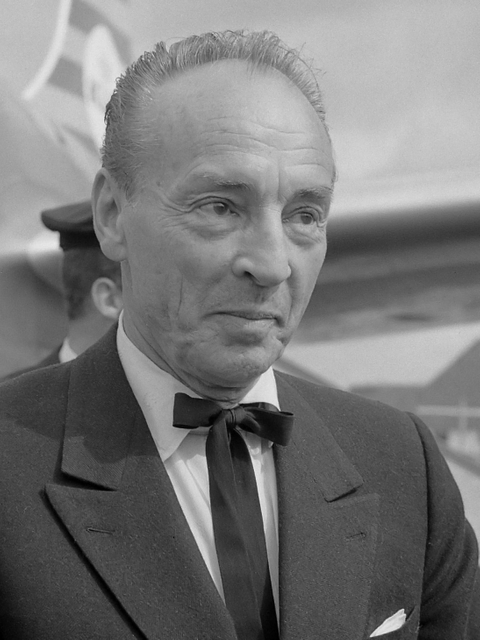
George Balanchine

| Born | |
|---|---|
| Died | April 30, 1983 (aged 79) |
| Occupation | Dancer, choreographer, actor, director |
| Years active | 1929–1983 |
| Alexandra Danilova(1926–1933) | |
| Awards | Presidential Medal of Freedom, among others (see below) |
George Balanchine (/ˈbælən(t)ʃiːn, ˌbælənˈ(t)ʃiːn/;[1] born Georgiy Melitonovich Balanchivadze; Russian: Гео́ргий Мелито́нович Баланчива́дзе, Georgian: გიორგი მელიტონის ძე ბალანჩივაძე; January 22, 1904 – April 30, 1983) was an American ballet choreographer who was one of the most influential 20th century choreographers.[2] Styled as the father of American ballet,[3] he co-founded the New York City Ballet and remained its Artistic Director for more than 35 years.[4]
Balanchine took the standards and technique from his time at the Imperial Ballet School and fused it with other schools of movement that he had adopted during his tenure on Broadway and in Hollywood, creating his signature "neoclassical style".[5]
He was a choreographer known for his musicality; he expressed music with dance and worked extensively with leading composers of his time like Igor Stravinsky.[6] Balanchine was invited to America in 1933 by a young arts patron named Lincoln Kirstein, and together they founded the School of American Ballet. Along with Kirstein, Balanchine also co-founded the New York City Ballet (NYCB).[4]
| Born | |
|---|---|
| Died | April 30, 1983 (aged 79) |
| Occupation | Dancer, choreographer, actor, director |
| Years active | 1929–1983 |
| Alexandra Danilova(1926–1933) | |
| Awards | Presidential Medal of Freedom, among others (see below) |
Early life
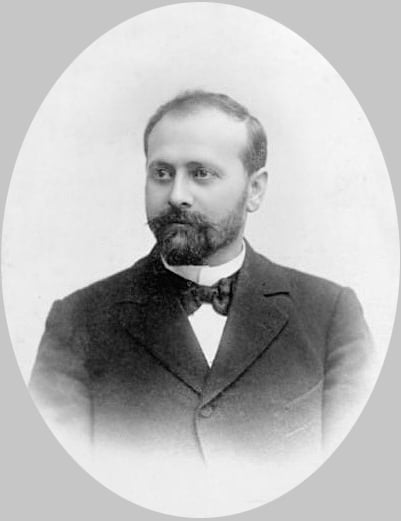
Balanchine's father Meliton
Balanchine was born Giorgi Melitonovitch Balanchivadze (Georgian: გიორგი მელიტონის ძე ბალანჩივაძე) in Saint Petersburg, Russian Empire, son of Georgian opera singer and composer Meliton Balanchivadze, one of the founders of the Tbilisi Opera and Ballet Theatre and later the culture minister of the Democratic Republic of Georgia, which became independent in 1918 but was later subsumed into the Soviet Union.[7]
The rest of the Georgian side of Balanchine's family comprised largely artists and soldiers.
Little is known of Balanchine's Russian, maternal side. His mother, Meliton's second wife, Maria Nikolayevna Vasilyeva, was fond of ballet and viewed it as a form of social advancement from the lower reaches of St. Petersburg society.[8]*Balanchine%20a]]*Balanchine%20a]]*he was eleven years younger than Meliton and rumored to have been his former housekeeper, although "she had at least some culture in her background" as she could play piano well.
Career
Early auditions and training
As a child, Balanchine was not particularly interested in ballet, but his mother insisted that he audition with his sister Tamara, who shared her mother's interest in the art.
Balanchine's brother Andria Balanchivadze instead followed his father's love for music and became a composer in Soviet Georgia. Tamara's career, however, would be cut short by her death in unknown circumstances as she was trying to escape on a train from besieged Leningrad to Georgia.[8]
Based on his audition, during 1913 (at age nine), Balanchine relocated from rural Finland to Saint Petersburg and was accepted into the Imperial Ballet School, principal school of the Imperial Ballet, where he was a student of Pavel Gerdt and Samuil Andrianov (Gerdt's son-in-law).[4]
After graduating in 1921, Balanchine enrolled in the Petrograd Conservatory while working in the corps de ballet at the State Academic Theater for Opera and Ballet (formerly the State Theater of Opera and Ballet and known as the Mariinsky Ballet). His studies at the conservatory included advanced piano, music theory, counterpoint, harmony, and composition. Balanchine graduated from the conservatory during 1923, and danced as a member of the corps until 1924. While still in his teens, Balanchine choreographed his first work, a pas de deux named La Nuit (1920, music by Anton Rubinstein). This was followed by another duet, Enigma, with the dancers in bare feet rather than ballet shoes. During 1923, with fellow dancers, Balanchine formed a small ensemble, the Young Ballet.
Ballets Russes
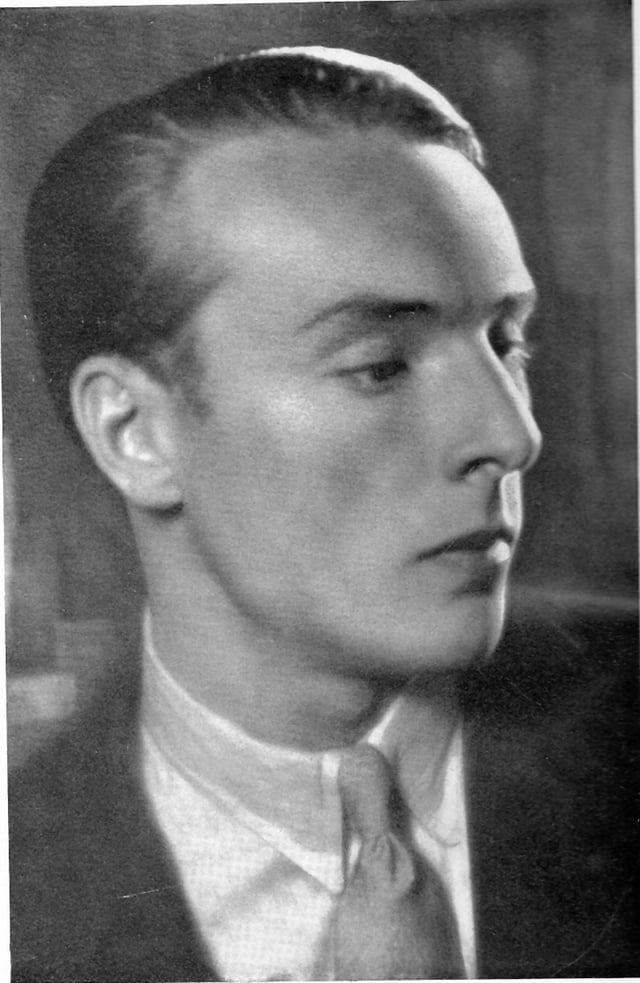
Young Balanchine, pictured in the 1920s.
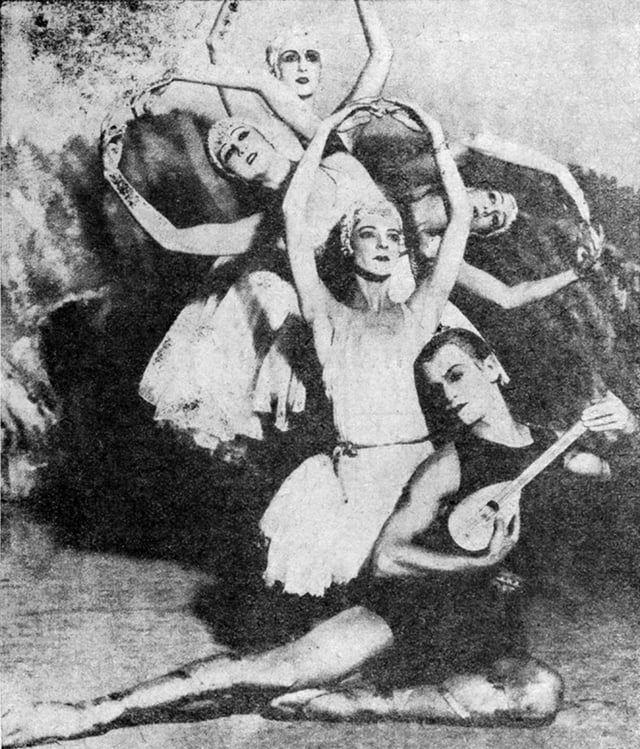
Apollo, 1928
On a 1924 visit to Germany with the Soviet State Dancers, Balanchine, his wife, Tamara Geva, and dancers Alexandra Danilova and Nicholas Efimov fled to Paris, where there was a large Russian community. At this time, the impresario Sergei Diaghilev invited Balanchine to join the Ballets Russes as a choreographer.[4]
Diaghilev soon promoted Balanchine to ballet master of the company and encouraged his choreography. Between 1924 and Diaghilev's death in 1929, Balanchine created nine ballets, as well as lesser works. During these years, he worked with composers such as Sergei Prokofiev, Igor Stravinsky, Claude Debussy, Erik Satie, and Maurice Ravel, and artists who designed sets and costumes, such as Pablo Picasso, Georges Rouault, and Henri Matisse, creating new works that combined all the arts.
Among his new works, during 1928 in Paris, Balanchine premiered Apollon musagète (Apollo and the muses) in a collaboration with Stravinsky; it was one of his most innovative ballets, combining classical ballet and classical Greek myth and images with jazz movement. He described it as "the turning point in my life".[10] Apollo is regarded as the original neoclassical ballet. Apollo brought the male dancer to the forefront, giving him two solos within the ballet. Apollo is known for its minimalism, utilizing simple costumes and sets. This allowed the audience not to be distracted from the movement. Balanchine considered music to be the primary influence on choreography, as opposed to the narrative.
Suffering a serious knee injury, Balanchine had to limit his dancing, effectively ending his performance career.
After Diaghilev's death, the Ballets Russes went bankrupt.
To earn money, Balanchine began to stage dances for Charles B. Cochran's revues and Sir Oswald Stoll's variety shows in London. He was retained by the Royal Danish Ballet in Copenhagen as a guest ballet master. Among his new works for the company were Danses Concertantes, a pure dance piece to music by Stravinsky, and Night Shadow, revived under the title La Sonnambula
In 1931, with the help from financier Serge Denham, René Blum and Colonel Wassily de Basil formed the Ballets Russes de Monte-Carlo,[11] a successor to Ballets Russes. The new company hired Leonide Massine and Balanchine as choreographers. Featured dancers included David Lichine and Tatiana Riabouchinska. In 1933, without consulting Blum, Col. de Basil dropped Balanchine after one year[12] – ostensibly because he thought that audiences preferred the works choreographed by Massine. Librettist Boris Kochno was also let go, while dancer Tamara Toumanova (a strong admirer of Balanchine's) left the company when Balanchine was fired.
Balanchine and Kochno immediately founded Les Ballets 1933, with Kochno, Diaghilev's former secretary and companion, serving as artistic advisor. The company was financed by Edward James, a British poet and ballet patron. The company lasted only a couple of months during 1933, performing only in Paris and London, when the Great Depression made arts more difficult to fund. Balanchine created several new works, including collaborations with composers Kurt Weill, Darius Milhaud, Henri Sauguet and designer Pavel Tchelitchew.
United States
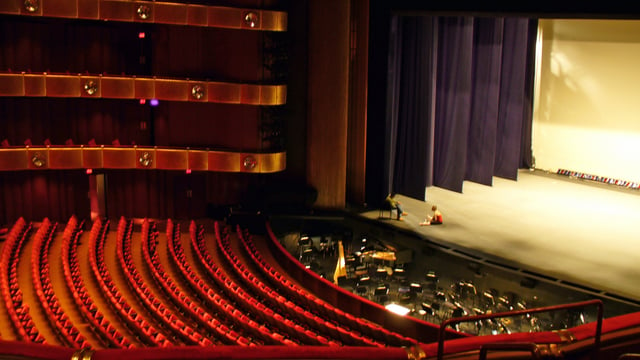
Architect Philip Johnson designed the New York State Theater to Balanchine's specifications.
Balanchine insisted that his first project in the United States would be to establish a ballet school because he wanted to develop dancers who had strong technique along with his particular style.
Compared to his classical training, he thought they could not dance well.
With the assistance of Lincoln Kirstein and Edward M.M. Warburg, the School of American Ballet opened to students on January 2, 1934, less than three months after Balanchine arrived in the U.S. Later that year, Balanchine had his students perform in a recital, where they premiered his new work Serenade
Between his ballet activities in the 1930s and 1940s, Balanchine choreographed for musical theater with such notables as Richard Rodgers, Lorenz Hart and Vernon Duke.[13] Balanchine choreographed Broadway's On Your Toes in 1936. This musical featured the ballet Slaughter on Tenth Avenue, in which a tap dancer falls in love with a dance-hall girl. His choreography in musicals was unique at the time because it furthered the plot of the story. [14]
Relocation to West Coast
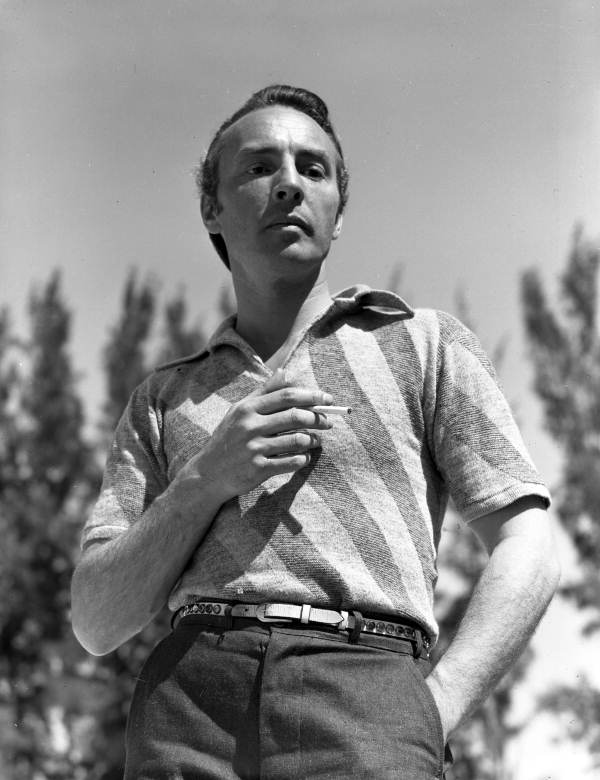
Balanchine in 1942
Balanchine relocated his company to Hollywood during 1938, where he rented a white two-story house with "Kolya", Nicholas Kopeikine, his "rehearsal pianist and lifelong colleague",[15] on North Fairfax Avenue not far from Hollywood Boulevard. Balanchine created dances for five movies, all of which featured Vera Zorina, whom he met on the set of The Goldwyn Follies and who subsequently became his third wife. He reconvened the company as the American Ballet Caravan and toured with it throughout North and South America, but it folded after several years. From 1944 to 1946, during and after World War II, Balanchine served as resident choreographer for Blum & Massine's new iteration of Ballet Russe de Monte-Carlo.
Return to New York
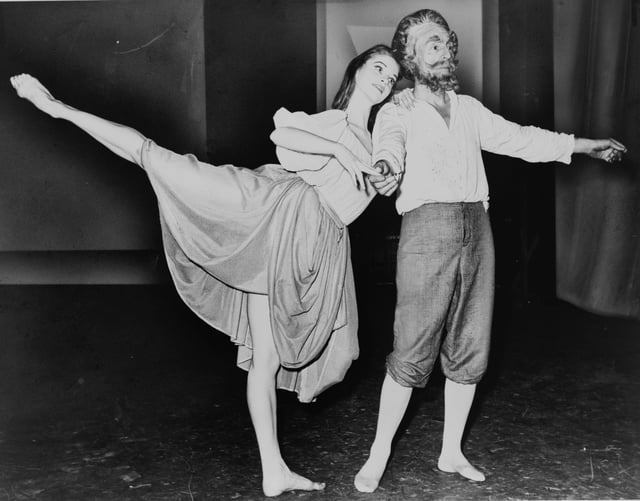
Balanchine with Suzanne Farrell in Don Quixote.
Soon Balanchine formed a new dance company, Ballet Society, again with the generous help of Lincoln Kirstein. He continued to work with contemporary composers such as Paul Hindemith, from whom he commissioned a score in 1940 for The Four Temperaments. First performed on November 20, 1946, this modernist work was one of his early abstract and spare ballets, angular and very different in movement. After several successful performances, the most notable featuring the ballet Orpheus created in collaboration with Stravinsky and sculptor and designer Isamu Noguchi, the City of New York offered the company residency at the New York City Center.
In 1954, Balanchine created his version of The Nutcracker, in which he played the mime role of Drosselmeyer. The company has since performed the ballet every year in New York City during the Christmas season. His other famous ballets created for New York companies include Firebird, Allegro Brilliante, Agon, The Seven Deadly Sins, and Episodes
In 1967, Balanchine's ballet Jewels displayed specific characteristics of Balanchine's choreography. The corps de ballet dancers execute rapid footwork and precise movements. The choreography is difficult to execute and all dancers must do their jobs in order to hold the integrity of the piece. Balanchine's use of musicality can also be seen in this work. His other famous works with New York City Ballet are popular today and are performed in the Lincoln Center by New York City Ballet: Mozartiana, Apollo, Orpheus, and A Midsummer Night's Dream
Death
In his last years, Balanchine suffered from angina pectoris and underwent heart bypass surgery.[16]
After years of illness, Balanchine died on 30 April 1983, aged 79, in Manhattan from Creutzfeldt–Jakob disease, which was diagnosed only after his death. He first showed symptoms during 1978 when he began losing his balance while dancing. As the disease progressed, his equilibrium, eyesight, and hearing deteriorated. By 1982, he was incapacitated. The night of his death, the company went on with its scheduled performance, which included Divertimento No. 15 and Symphony in C at Lincoln Center.[17]
Clement Crisp, one of the many writers who eulogized Balanchine, assessed his contribution: "It is hard to think of the ballet world without the colossal presence of George Balanchine..."
In his lifetime he created 465 works.
Balanchine extended the traditions of classical ballet. His choreography remains the same to the present day and the School of American Ballet still uses his teaching technique. As one of the 20th century's best-known choreographers, his style and vision of ballet is interesting to many generations of choreographers.
He had a Russian Orthodox funeral, and was interred at the Oakland Cemetery at Sag Harbor, Suffolk County, New York at the same cemetery where Alexandra Danilova was later interred.[18]
Personal life
In 1923, Balanchine married Tamara Geva, a sixteen-year-old dancer. After his divorce from Geva, Balanchine was partnered with Alexandra Danilova from 1926 through 1933. He married and divorced three more times, all to women who were his dancers: Vera Zorina (1938–1946), Maria Tallchief (1946–1952), and Tanaquil LeClercq (1952–1969). He had no children by any of his marriages and no known offspring from any extramarital unions or other liaisons.
Biographer and intellectual historian Clive James has argued that Balanchine, despite his creative genius and brilliance as a ballet choreographer, had his darker side.
In his Cultural Amnesia: Necessary Memories from History and the Arts (2007), James writes that:
the great choreographer ruled the New York City Ballet as a fiefdom, with the 'droit du seigneur' among his privileges. The older he became, the more consuming his love affairs with his young ballerinas... When [ballerina Suzanne Farrell] fell in love with and married a young dancer, Balanchine dismissed her from the company, thereby injuring her career for a crucial decade.
Legacy and honors
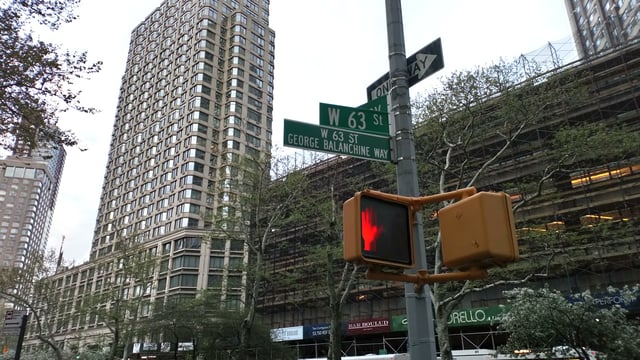
George Balanchine Way in New York.
With his School of American Ballet, New York City Ballet, and 400 choreographed works, Balanchine transformed American dance and created neoclassical ballet, developing a unique style with his dancers highlighted by brilliant speed and attack.
A monument at the Tbilisi Opera and Ballet Theatre was dedicated in Balanchine's memory. A crater on Mercury was named in his honor.
George Balanchine Way is a segment of West 63rd Street (located between Columbus Avenue and Broadway) in New York City that was renamed in his honor in June 1990.
Awards
1975 French Légion d'honneur
1978 Kennedy Center Honors
1980 Austrian Decoration for Science and Art[19]
1987 National Museum of Dance's Mr. & Mrs. Cornelius Vanderbilt Whitney Hall of Fame (posthumously)
1988 Induction into the American Theater Hall of Fame[20][21]
Kisselgoff, Anna. "Balanchine 100: The Centennial Celebration"[22]
Selected choreographed works
1928 Apollo
1929 The Prodigal Son
1935 Serenade
1936 Slaughter on Tenth Avenue
1936 Zenobia
1937 Jeu de cartes
1941 Concerto Barocco
1941 Tschaikovsky Piano Concerto No. 2
1942 Circus Polka
1946 La Sonnambula
1946 The Four Temperaments
1947 Symphonie Concertante
1947 Symphony in C
1947 Theme and Variations
1948 Orpheus
1949 Bourrée fantasque
1949 The Firebird
1951 La Valse
1951 Swan Lake
1952 Bayou
1952 Scotch Symphony
1954 Ivesiana
1954 Western Symphony
1956 Allegro Brillante
1956 Divertimento No. 15
1957 Agon
1957 Square Dance
1958 Gounod Symphony
1958 Stars and Stripes
1959 Episodes
1960 Donizetti Variations
1960 Liebeslieder Walzer
1960 Monumentum pro Gesualdo
1960 Ragtime (I)
1960 Tschaikovsky Pas de Deux
1961 Raymonda Variations
1962 A Midsummer Night's Dream
1963 Bugaku
1964 Tarantella
1965 Don Quixote
1965 Harlequinade
1966 Brahms–Schoenberg Quartet
1966 Variations
1967 Divertimento Brillante
1967 Jewels Emeralds Rubies Diamonds
1967 Ragtime (II)
1968 Metastaseis and Pithoprakta
1968 Requiem Canticles
1968 La Source
1968 Slaughter on Tenth Avenue
1970 Tschaikovsky Suite No. 3
1970 Who Cares?
1972 Duo Concertant
1972 Pulcinella
1972 Scherzo à la russe
1972 Stravinsky Violin Concerto
1972 Symphony in Three Movements
1973 Cortège Hongrois
1975 Le tombeau de Couperin
1975 The Steadfast Tin Soldier
1976 Chaconne
1976 Union Jack
1977 Vienna Waltzes
1978 Ballo della Regina
1978 Kammermusik No. 2
1979 Le Bourgeois Gentilhomme
1980 Robert Schumann’s Davidsbündlertänze
1980 Walpurgisnacht Ballet
1981 Garland Dance
1981 Mozartiana
1982 Élégie
1982 Noah and the Flood
Notable students
Over the decades Balanchine shared his artistic insights with several of his students including:
See also
Balanchine method
Contemporary ballet
List of Russian ballet dancers
List of Eastern Bloc defectors
Category: Ballets by George Balanchine